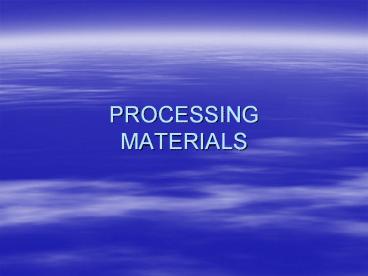PROCESSING MATERIALS - PowerPoint PPT Presentation
Title:
PROCESSING MATERIALS
Description:
PROCESSING MATERIALS Processing Materials Materials are processed to make them more useful --- changing from one form to another Value is added by each process ... – PowerPoint PPT presentation
Number of Views:61
Avg rating:3.0/5.0
Title: PROCESSING MATERIALS
1
PROCESSING MATERIALS
2
Processing Materials
- Materials are processed to make them more useful
--- changing from one form to another - Value is added by each process
- Primary Industry
- Produces basic industrial materials used to make
basic industrial materials - Iron ore steel structures, Crude oil
chemicals plastics - Rubber (latex) is heated with sulfur ---
Vulcanization
Cotton thread
Wood paper
Steel structures
Animal Hides shoes
3
Industrial Materials
- Wood
- Hard wood --- broad leaves --- deciduous, e.g.
maple, oak - Soft wood --- thin leaves --- coniferous, e.g.
pine - Plywood (a manufactured board) is made from wood
chips and saw dust. - Metals
- Metals, e.g. iron are used to make heavy
structures, automobiles, planes and tools etc. - Alloys are the combination of two or more metals
- Brass Copper Zinc, Bronze Copper
Tin, Pewter Tin, Antimony and Copper - Ferrous metals --- more than 50 iron
- Stainless steel containing chromium resists
rusting
4
Industrial Materials
- Ceramics
- Objects obtained from clay like materials such as
plaster, cement, limestone and glass --- pottery,
fiber glass, sockets, switches - They are heated (fired) to around 2000 F in an
oven called kiln - Glazing is coating them with glass-like materials
- High strength ceramics are used in planes,
automobiles - Soda lime glass sand, lime and sodium oxide
at around 2500 F - Plastics
- Long chain molecules --- polymers
- Thermoplastics --- soften when heated and harden
when cooled again, e.g. polythene bags, PVC bags - Thermoset --- do not soften when heated. They
rather char and burn instead, e.g. bakelite,
Formica and plastic cups
5
Industrial Materials
- How Steel is Made
- Iron ore (iron oxide) is melted with limestone
and coke in a blast furnace - Molten iron cools and hardens into pig iron
- Impurities are removed as slag
- Hot metal is turned into steel in basic oxygen
furnaces (BOFs) - Steel is also made in open-hearth furnaces and
electric furnaces - Huge blocks of molten steel are called ingots ---
bars, rods and sheets - Changing molten steel directly into basic shapes
--- continuous casting
6
(No Transcript)
7
Processing Materials
- Forming --- changing shape
- Separating --- removing a part
- Combining --- joining materials together
- Conditioning --- changing internal properties
8
Forming Processes
- Casting
- Castings are made from molds --- ice cubes, walk
on a beach, cake pan - One-piece and two-piece molds
- Slip is the liquid clay poured into a two-piece
mold - Pressing
- Pressing is like casting with a plunger
- Meat can be pressed into shape with hands
- Powdered metal pressed and heated --- sintering
- Forging
- Heating a metal and hammering into a shape ---
blacksmith, coins - Hydraulic and mechanical presses use powerful
rams --- thousand tons of force
9
(No Transcript)
10
Forming Processes
- Extruding
- Soft metal pressed/squeezed through an opening,
e.g toothpaste - End products do not require much more shaping and
machining - Blow Molding
- Air blows the plastic into a mold, e.g plastic
bottles - Vacuum Forming
- A vacuum pulls the warm, soft plastic down
- The plastic clings to whatever it is drawn
against, e.g. blister packaging
11
Separating Processes
- Shearing
- Using knife-like blade for separating
- When the force gets high enough, the material
breaks along the line of the cut - Sawing
- Separating with a blade that has teeth
- Cutting wood along the direction of the grain ---
Ripping - Cutting wood across the direction of the grain
--- Crosscutting - Handsaws used for wood have 6-10 tpi
- Metal is cut by hand using a hacksaw --- usually
18 tpi - Machine saws and table saws































